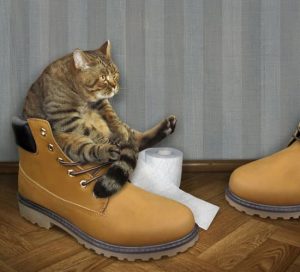Inappropriate elimination is the number one reported behavioural problem in cats. It is important you rule out underlying physical problems first such as bladder infection, bowel infections, diabetes, kidney failure or other systemic disease. Once these physical problems are ruled out we then determine whether the cat is urine marking or toileting. A cat that is marking will stand upright on all four feet with tail held erect and spray a small amount, typically on vertical surfaces such as walls or furniture. A large number of cats in one household or outdoor cats lingering around windows or doors can cause heightened anxiety leading to urine marking.
A cat that is toileting with urine will typically squat as she does in the litter box and leave a significant amount on a horizontal surface, such as carpet, bedding, or couch cushions. It is especially important to rule out a medical condition if your cat is toileting large amounts of urine outside the litter box.
The majority of elimination problems are related to improper litter box management. The rule of thumb for number of litter boxes is one box per cat, plus one. Boxes need to be on all levels of the house in easy to access locations. Most cats prefer unscented, clumping litter in an uncovered, unlined box. Boxes should be scooped 1-2 times daily, and completely changed and cleaned weekly.
Main causes of cat’s soiling outside of the litter box
- Litter box aversion (often just outside box or doesn’t cover excrement with litter) > something about the box is bothering the cat. Make sure it’s clean, uncovered and unlined. Also consider wall height and litter depth. Experiment with different boxes. A previously painful experience (e.g. constipation) might mean you have to change the type and location of the box.
- Substrate aversion > texture and scent of litter are important! Many dislike the large, crystal type litter. Longhaired cats might dislike it getting caught in their feet so trim their feet regularly.
- Substrate preference > cats usually prefer a specific type of litter, usually clumping and unscented. For cats who prefer soft, absorbent litter you may need to put pieces of this in with the litter for the initial retraining period. To get them stop urinating in other locations, place foil or upside down carpet runners on the areas or block them off completely.
- Location aversion > be wary of what noises might frighten the cat e.g. a washing machine. Older cats may not like high surfaces or upstairs. Multiple cat households may have cats guarding certain areas so give the other cats multiple options. High traffic areas are usually unappealing and most cats like their litter separate to their eating area. As mentioned early a negative association with a specific location can prevent a cat from using the area for elimination.
- Location preference > cats may choose a more preferable area to urinate in and by simply placing a litter tray there you may solve the problem e.g. a back, quiet bedroom.
- Anxiety > this is a major contributing factor in many cases and must be addressed:
a. Too many cats can be a stressor
b. Stray cats may be tormenting them e.g. window near litter tray
Petcare Information
Updated P Honson July 2018. Property of Thornleigh Vet Hospital
c. Major changes in the house e.g. new baby
d. An anti-anxiety medication may be necessary if anxiety is a component of the problem.
It is important to remember urinating and defecating can be an anxiety-relieving activity for a cat and it in no way signifies that a cat is “getting even” or “mad at you.” Harsh punishment for such acts will only heighten anxiety and make the problem worse.
**Reference – Herron, M. Let’s talk excrement – feline elimination problems. Proceedings of 4th AVA/NZVA Pan Pacific Conference, Brisbane 2015.



